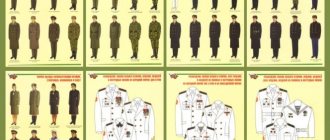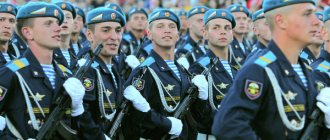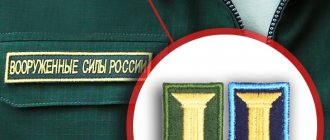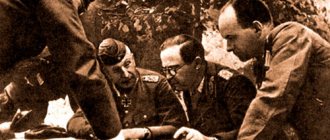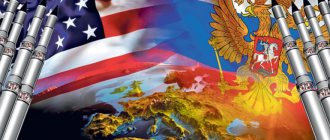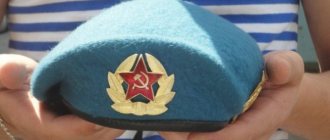Who wears one shoulder strap?
Until 1938, the ranks of members of the SS organization were distinguished only by their buttonholes. There was only one shoulder strap on the black uniform, on the right shoulder, and by it only the category of SS member could be distinguished (private and non-commissioned officers, junior officers, senior officers, generals).
Interesting materials:
How to calculate sick leave if there is no work experience? How to calculate when my last working day will be? How to calculate compensation for unused vacation If an employee has worked for a month? How to calculate vacation pay if vacation falls on holidays? How to calculate salary if there was a vacation? How to remove the director of an LLC if he is the founder? How to lay off a pensioner if he doesn’t want to? How to remove if you were tagged on Instagram? How to care for cyclamen when it blooms? How can I see where the bus is?
Hugo Boss military uniform. Designer Karl Diebitsch
Culture never exists independently; it is not separated, not cut off. Culture is always inscribed in society itself. There is politics, there is economics, there is culture. Different spheres of social life, but they are always together and nearby, closely connected and sometimes confused. If a society has some kind of political system that has its own goals and objectives, and most importantly ideas, then it will certainly give rise to its own culture. This is both literature and art. Everywhere there will be an imprint of the ideas that dominate society. Be it the construction of buildings, paintings by artists or fashion. Fashion can also be linked to politics, intertwined with an idea, tied to propaganda.
Military fashion. Why not? After all, the uniform of the Third Reich is still considered the most beautiful uniform. Uniform from Hugo Boss . Today Hugo Boss apologizes. However, they have a good company: Volkswagen, Siemens, BMW. They collaborated with the Nazis; captured Poles and French worked at their enterprises in terrible conditions. They were sewing uniforms. Uniform for the military of the Third Reich. However, at that time Hugo Boss was not yet a large company and a well-known brand. Hugo Ferdinand Bossovic Blase opened his tailoring workshop in 1923. I sewed overalls, windbreakers, and raincoats mainly for workers. The income was not great and tailor Hugo Boss understands that only a military order can save his business. However, Hugo Boss was only one of 75,000 German private tailors sewing the army. He also sewed SS uniforms.
The author of the black SS uniform, as well as many of the regalia of the Third Reich, was Karl Diebitsch. He was born in 1899. He would die many years after the end of World War II in 1985. His ancestors come from Silesia, possibly from Poland. Designer by training. He also served in the SS as an Oberfuhrer. He designed the SS uniforms together with graphic designer Walter Heck. Diebitsch also designed the Ahnenerbe logo and crosses for SS officers. A kind of genius, talent, in the service of the forces of darkness. By the way, Diebitsch was also the director of the Porzellan Manufaktur Allach porcelain factory in 1936 before the factory was transferred to the SS department and moved to Dachau.
Walter Heck, a graphic artist, was also an SS-Hauptsturmführer. It was he who developed the SS emblem in 1933, combining two “Zig” runes (the “Zig” rune - lightning in ancient German mythology was considered a symbol of the god of war Thor). He also designed the SA emblem. And together with Karl Diebitsch he created the SS uniform.
Here's the story. The history of military uniforms, which had their own designers.
Nakhodka in Besh-Kungei
According to official data, in April 2014, a treasure from the World War II era was found by citizen D. Lukichev in the village of Besh-Kungei (Kyrgyzstan). While digging a cesspool, he came across a metal army field locker from the Third Reich. Its contents are luggage items from 1944-1945. (age - more than 60 years), which was not damaged by moisture due to dense insulation through the rubber gasket of the box lid.
It included:
- a light-colored case with the inscription “Mastenbrille” containing glasses;
- a rolled-up travel bag with pockets filled with toiletries;
- mittens, replacement collars, socks with foot wraps, clothes brush, sweater, suspenders and dust protectors;
- a bundle tied with twine containing a supply of leather and fabric for repairs;
- granules of some kind of product (presumably anti-moth);
- an almost new jacket worn by a Wehrmacht officer, with a spare sewn-on emblem of the branch of service and a metal badge;
- headdresses (winter hat and cap) with insignia;
- military passes through front-line checkpoints;
- a banknote of five Reichsmarks;
- a couple of bottles of rum;
- box of cigars
Dmitry thought about donating most of the uniform to the museum. As for the bottles of rum, the box of cigars and the jacket worn by the Wehrmacht officer, he wants to keep them according to the legal 25% granted by the state when finding historical value.
Wehrmacht women's uniform
After the outbreak of hostilities in the European TBD (theater of combat), there was a need to expand support units and personnel. These positions were well suited to be filled by female military personnel. Therefore, by OKW order No. 1085 of 01.10.1940, first the Women's Auxiliary Communications Service (from German: Nachrichtenhelferinnen) was created, and then other auxiliary services. Army uniforms were provided for female soldiers.
The Waffen-SS women's uniform consisted of a gray jacket and skirt, as well as a black cap with the image of the German eagle.
Female SS uniform
The most famous female member of the SS was probably Irma Grese. Rape by her own father at the age of 12 (according to other sources, brother, uncle), hard village life greatly influenced the consciousness of the young girl, giving birth to sadistic tendencies in her soul. Having voluntarily joined the auxiliary units of the SS in 1942, she was appointed as a guard at the Ravensbrück concentration camp. Then she was transferred several more times to other camps. And everywhere she happily tortured female prisoners of the concentration camp, she loved to shoot the prisoners she chose. The list of tortures used by her is very extensive. In fact, torture gave her sexual pleasure. The torture was followed by sexual orgies with the guards and commanders of the concentration camps. In 1945, she was captured by the British, sentenced to death and hanged in prison.
Irma Grenze - "The Blonde Devil"
Buttonholes and shoulder straps of generals
As mentioned earlier, Wehrmacht generals wore shoulder straps, which were woven using two thick gold-metal strands and a silver soutache between them.
They also had removable shoulder straps, which (as in the case of the ground forces) had a scarlet cloth lining with a special figured cutout running along the edge of the harness (their lower edge). And the bent and sewn-in shoulder straps were distinguished by a straight lining.
Wehrmacht generals wore silver stars on their shoulder straps, but there was some difference: major generals had no stars, lieutenant generals had one, a general of a certain type of troops (infantry, tank troops, cavalry, etc.) had two, oberst general - three (two stars located next to each other at the bottom of the shoulder strap and one slightly above them). Previously, there was such a rank as Colonel General in the position of Field Marshal General, which was not used at the beginning of the war. The shoulder strap of this rank had two stars, which were located in its upper and lower parts. A field marshal could be identified by the crossed silver batons along his shoulder straps.
There were also exceptional moments. So, for example, Gerd von Rundstedt (Field Marshal General, who was removed from command due to the defeat near Rostov, chief of the 18th Infantry Regiment) wore the regiment number on his shoulder straps on top of his field marshal's batons, as well as the white and silver ceremonial buttonholes of an infantry officer on his collar troops in return for the richly ornamented gold buttonholes embroidered on a scarlet cloth flap (size 40x90 mm) for generals. Their design was found back in the days of the Kaiser’s army and the Reichswehr; with the formation of the GDR and the Federal Republic of Germany, it also appeared among generals.
From the beginning of April 1941, elongated buttonholes were introduced for field marshals, which had three (instead of the previous two) ornamental elements and shoulder straps made of golden thickened cords.
Another sign of the general's dignity is stripes.
The field marshal could also carry in his hand a natural staff, which was made of particularly valuable wood, individually decorated, generously inlaid with silver and gold and decorated with reliefs.
What is special about the Wehrmacht uniform?
The uniform of the German army at the beginning of World War II compared favorably with the uniform of other belligerent armies. In the Wehrmacht, they were the first to indicate belonging to a participating country (eagle), the types of troops were clearly designated, and there was no confusion with the ranks of officers for the soldiers of their army.
However, frosty Russia quickly revealed the shortcomings of the uniform: there are cold overcoats, especially when the Red Army en masse changed into quilted jackets. That is why it was so often possible to see captured Germans dressed haphazardly in the winter. In the summer, it was terribly hot in field jackets, which forced the soldiers to unbutton and roll up their sleeves. This fact received a lot of attention in Soviet cinema.
But the author cannot fail to mention the following fact. The color, appearance and shape of the Wehrmacht is very well ingrained in the genes of the Russian people. The author somehow accidentally saw people in the uniform of Hitler’s army, and although he had never seen such a uniform in person in his life, there was a very clear message from the subconscious that he had to go and kill them. Due to the lack of a machine gun at hand, the author approached the people in the feldgrau almost unarmed and found out that they were actors from the film set. Therefore, the heart let go of hatred, and everyone remained unharmed.
Wehrmacht uniform
Shoulder straps in German military uniform
They had a dual purpose: as a means of determining rank and as carriers of a unitary function (fastening various types of equipment on the shoulder).
Shoulder straps of the Wehrmacht (rank and file) were made of simple cloth, but with edging, which had a certain color corresponding to the branch of the army. If we take into account the shoulder straps of a non-commissioned officer, we can note the presence of an additional edging consisting of braid (width - nine millimeters).
Until 1938, there was a special army shoulder strap exclusively for field uniforms, which was worn by all ranks below officer. It was entirely dark blue-green with a slightly tapered end towards the button. There was no fixed edging on it corresponding to the color of the branch of service. Wehrmacht soldiers, in order to highlight the color of the military branches, embroidered insignia (numbers, letters, emblems) on them.
The officers (lieutenants, captains) had narrower shoulder straps, which looked like two intertwined strands made of flat silver “Russian braid” (the strand is woven in such a way that thinner threads are visible). All strands were sewn onto the flap in the color of the branch of the military that is the basis of this shoulder strap. A special bend (U-shaped) of the braid in the place of the button hole helped create the illusion of eight strands of it, when in fact there were only two.
Wehrmacht (staff officer) shoulder straps were also made using Russian braid, but in such a way as to demonstrate a row consisting of five separate loops located on either side of the shoulder strap, in addition to the loop around the button located at the top of it.
The general's shoulder straps had a distinctive feature - “Russian braid”. It was made from two separate gold strands, twisted on both sides with one silver ribbed thread. The weaving method implied the appearance of three knots in the middle and four loops on each side in addition to one loop located around the button at the top of the shoulder strap.
Wehrmacht officials, as a rule, had the same shoulder straps as those of the active army. However, they were still distinguished by the slight introduction of a thread of dark green braid and various kinds of emblems.
It would not be amiss to remind you once again that shoulder straps are insignia of the Wehrmacht.
Uniforms and insignia of the Wehrmacht
The German army had several types of uniforms and clothing. Each soldier had to independently monitor the condition of his weapons and uniform. They were replaced in accordance with the established procedure or in case of serious damage during the training process. Military uniforms lost color very quickly due to washing and daily brushing.
The soldiers' shoes were thoroughly inspected (at all times, bad boots were a serious problem).
Since the formation of the Reichswehr (German armed forces in the period 1919 - 1935), the military uniform has become unified for all existing German states. Its color is “feldgrau” (translated as “field grey”) - a wormwood shade with a predominant green pigment.
A new uniform (the uniform of the Wehrmacht - the armed forces of Nazi Germany during the period 1935 - 1945) was introduced along with a new model of steel helmet. The ammunition, uniforms and helmets did not differ in appearance from their predecessors (existing in the Kaiser's era).
At the whim of the Fuhrer, the attire of the military personnel was emphasized by a large number of various elements of heraldry (emblems, signs, stripes, piping, badges, etc.). Devotion to National Socialism was expressed by applying the black, white and red imperial cockade and the tricolor shield on the right side of the helmet. The appearance of the imperial tricolor dates back to mid-March 1933. In October 1935, the uniform was supplemented by an imperial eagle holding a swastika in its claws. At this time, the Reichswehr was renamed the Wehrmacht (photo was shown earlier).
This topic will be considered in relation to the Ground Forces and SS troops.
